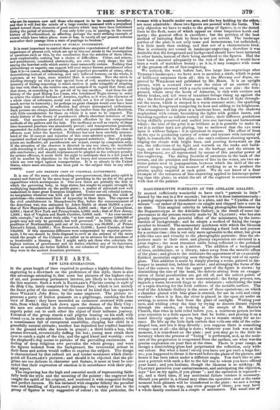FINE ARTS.
NEW LINE-ENGRAVINGS.
IF the great length of time required to produce a highly-finished line- engraving be a drawback on the preference of this style, there is also this advantage attending it, that none but pictures of the highest class of art, and possessing permanent interest, are likely to be executed in the line manner. Such a work is EASTLLHE'S Pilgrims coming in sight of the Holy City, lately completed by GEORGE Doo ; which is not merely the finest print of the season, but the best of its kind that has appeared since %Lam's John Knox, by the same engraver. The picture re- presents a party of Italian peasants on a pilgrimage, catching the first view of Rome : they have ascended an eminence crowned with some ruin, from which they look down upon the domes of the Holy City : the men are absorbed in devotional contemplation, and the women eagerly point out to each other the object of their toilsome journey. Foremost of the group stands a tall pilgrim leaning on his staff, with closed eyes, in mute adoration ; beside him kneels a young mother, with a countenance full of enraptured sensibility, clasping her child in a gracefully natural attitude; another has deposited her cradled bambino on the ground while she kneels in prayer ; a third holds a boy, who presses forward, reverentially doffing his hat ; young men strain their eyes to catch a sight of the city, and the aged kneel and worship : even the shepherd's dog seems to partake of the prevailing excitement. A feeling of deep religious awe pervades the whole group ; and were the figures isolated from the background, the reverential ardour in their faces and action would suffice to express the subject. The design is characterized by that refined art and tender sentiment which distin- guish all EASTLAKE'S pictures ; and should it be objected that the pil- grims are too delicate in character and feature, it must at least be con- ceded that their expression of emotion is in accordance with their phy- sical aspect.
The engraving has the high and essential merit of representing faith- fully both the style and the meaning of the painter : the engraver has caught the spirit of his original, and rendered it with congenial feeling and perfect success. He has imitated with singular felicity the peculiar tone and handling of EASTLAKE'S painting : the variety of tint in the group of figures is very suggestive of colour ; in this particular, the
woman with a bundle under one arm, and the boy holding by the other, are most admirable : these two figures are painted with the burin. The only objection we have to make to the group of figures, is to the dotted lines in the flesh, some of which appear on close inspection harsh and spotty : the general effect is excellent ; but the problem of the best method of imitating flesh by lines is not yet solved. The landscape portion of the plate is not only tame and monotonous, but unfinished ; it is little more than etching, and that not of a characteristic kind. Doo is evidently not versed in landscape-engraving ; therefore it was desirable that the foreground and background should have been intrusted to other hands, instead of their being sacrificed to the figures. Had the view been executed adequately to the rest of the plate, it would have been a work of matchless beauty ; as it is, it may compare with some of the greatest effats of line-engraving. We noticed, the week before last, five large line-engravings after TURNER'S landscapes ; we have now to mention a sixth, which in point of brilliancy surpasses them all : this is the Mercury and Argus, en- graved by WILLMORE and published by Mr. Moon. It is an upright picture, with a seaward view over the ruins of an ancient city ; a rocky height crowned with a castle towering on one side : the fore- ground, where stray the herds of Admetus, is rich with verdure and briery brakes, and tall trees of luxuriant foliage rising up against the sky : the fervid glow of a blazing sun diffuses a flood of light through- out the scene, which is steeped in a warm summer mist ; the sparkling water in the foreground tempering its beat and adding to its brightness. The atmosphere in this plate is a luminous haze, making the shadows resplendent with colour, burnishing the lights with golden lustre, and blending together an infinite variety of tints; their different gradations being skilfully preserved and melted into one lustrous and harmonious whole : the tone of the print is as brilliant as it is possible to make it; yet it is neither hard nor glaring, but so mellowed that the eye rests upon it without fatigue it is splendour in repose. The effect of lines on the eye in producing variety of colour and texture with intensity of light, is remarkable in this plate : the sun's radiance shooting upward, tinging the clouds with bright hues, and pouring downward on the sea, the reflections of its light and warmth on the rocks and build- ings, and its more dazzling effect on the herbage and the stream in the foreground, are all represented by means of this peculiar power of line-engraving. The daring freedom of execution in the bank of the stream, and the precision and firmness of line in the water, are two ex- treme points seen in juxtaposition, between which the skill of the en- graver ranges, varying his manner of working so as to produce the precise quality required at each point. We do not know of a finer example of the resources of line-engraving applied to landscape-paint- ing than this plate ; in which the art of the engraver is commensurate with that of the painter.
























 Previous page
Previous page